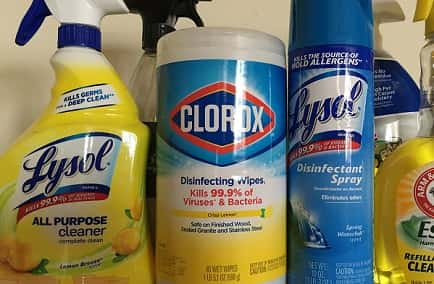
A survey conducted in May by the Centers for Disease Control and Prevention (CDC) shows nearly 40 percent of Americans report misusing cleaning supplies to prevent coronavirus (COVID-19) transmission, including using bleach on food.
According to the report, 39 percent of respondents reported intentionally engaging in at least one high-risk practice not recommended by CDC for preventing COVID-19 transmission:
- 19 percent said they have applied bleach to food items to sanitize them
- 18 percent have used household cleaning and disinfectant products on hands or other parts of their bodies
- 10 percent said they have misted their body with a cleaning or disinfect spray
- Four percent reported drinking or gargling with diluted bleach solutions, soapy water or other cleaning and disinfectant solutions.
The CDC said about 25 percent of respondents reported at least one adverse health effect they believe resulted from using cleaners or disinfectants, including nose or sinus irritation (11 percent); skin irritation (eight percent); eye irritation (eight percent); or dizziness, lightheadedness or headaches (eight percent).
Instead of potentially poisoning oneself, the CDC recommends the following guidelines to help prevent the spread of COVID-19:
Wash your hands often
- Wash your hands often with soap and water for at least 20 seconds especially after you have been in a public place, or after blowing your nose, coughing, or sneezing.
- If soap and water are not readily available, use a hand sanitizer that contains at least 60 percent alcohol. Cover all surfaces of your hands and rub them together until they feel dry.
- Avoid touching your eyes, nose, and mouth with unwashed hands.
Avoid close contact
- Avoid close contact with people who are sick, even inside your home. If possible, maintain 6 feet between the person who is sick and other household members.
- Put distance between yourself and other people outside of your home.
- Remember that some people without symptoms may be able to spread virus.
- Stay at least 6 feet (about 2 arms’ length) from other people.
- Do not gather in groups.
- Stay out of crowded places and avoid mass gatherings.
- Keeping distance from others is especially important for people who are at higher risk of getting very sick.
Cover your mouth and nose with a cloth face cover when around others
- You could spread COVID-19 to others even if you do not feel sick.
- Everyone should wear a cloth face cover when they have to go out in public, for example to the grocery store or to pick up other necessities.
- The cloth face cover is meant to protect other people in case you are infected.
- Do NOT use a facemask meant for a healthcare worker.
- Continue to keep about 6 feet between yourself and others. The cloth face cover is not a substitute for social distancing.
Cover coughs and sneezes
- If you are in a private setting and do not have on your cloth face covering, remember to always cover your mouth and nose with a tissue when you cough or sneeze or use the inside of your elbow.
- Throw used tissues in the trash.
- Immediately wash your hands with soap and water for at least 20 seconds. If soap and water are not readily available, clean your hands with a hand sanitizer that contains at least 60% alcohol.
Clean and disinfect
- Clean AND disinfect frequently touched surfaces daily. This includes tables, doorknobs, light switches, countertops, handles, desks, phones, keyboards, toilets, faucets, and sinks.
- If surfaces are dirty, clean them. Use detergent or soap and water prior to disinfection.
- Then, use a household disinfectant.
Monitor Your Health
- Be alert for symptoms. Watch for fever, cough, shortness of breath, or other symptoms of COVID-19.
- Especially important if you are running essential errands, going into the office or workplace, and in settings where it may be difficult to keep a physical distance of 6 feet.
- Take your temperature if symptoms develop.
- Don’t take your temperature within 30 minutes of exercising or after taking medications that could lower your temperature, like acetaminophen.
By Ken Howlett, News Director
Contact Ken at ken@k105.com








